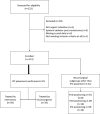From indication to initiation of invasive intracranial pressure monitoring time differences between neurosurgeons and intensive care physicians: can intracranial hypertension dose be reduced? TIMING-ICP, a multicenter, observational, prospective study
- PMID: 40506776
- PMCID: PMC12164138
- DOI: 10.1186/s13054-025-05384-w
From indication to initiation of invasive intracranial pressure monitoring time differences between neurosurgeons and intensive care physicians: can intracranial hypertension dose be reduced? TIMING-ICP, a multicenter, observational, prospective study
Abstract
Background: The duration of episodes of intracranial hypertension is related to poor outcome, hence the need for prompt diagnosis. Numerous issues can lead to delays in the implementation of invasive intracranial pressure (ICP) monitoring, thereby increasing the dose of intracranial hypertension to which the patient is exposed. The aim of this prospective, observational, multicenter study was to assess the magnitude of this delay, evaluating the time required for initiation of invasive ICP monitoring, from indication (T1) to initiation of the maneuver (T2) when performed by neurosurgeons compared to intensive care physicians.
Methods: We evaluated the impact of the operator performing the maneuver (neurosurgeon vs. intensivist) on the T2-T1 time interval, where T1 represents the time at which indication for invasive ICP monitoring is declared, and T2 the time at which the maneuver starts, defined as the skin incision. The effect of the operator performing the maneuver was evaluated through a parametric survival model. Both intraparenchymal catheters (IPCs) and external ventricular drains (EVDs) were considered as invasive ICP monitoring devices. Invasive monitoring could be performed in intensive care unit (ICU) or in operating room (OR).
Results: A total of 112 patients were included into the final analysis; 39 IPCs were placed by intensivists within the ICU, and a total of 73 IPCs and EVDs by neurosurgeons both within the ICU and OR settings. The mean difference in T2-T1 time for IPCs placement in the ICU was 69 min (CI 50.1-94.8) in the intensivist group and 145 min (CI 103.4-202.9) in neurosurgeon group. The mean difference between these groups, 76 min, was found to be statistically significant (p-value = 0.0021). In the group treated by neurosurgeons, no statistically significant differences were found in timing between the ICU and the OR.
Conclusions: Invasive ICP monitoring performed with IPCs in ICU begins earlier when performed by intensivists rather than neurosurgeons. This finding suggests the possibility to obtain a prompt diagnosis of intracranial hypertension when intensivists intervein directly at patient's bedside. Further studies are needed to confirm these findings and investigate their effect on outcome.
Keywords: Intensive care physicians; Intracranial hypertension; Intracranial pressure dose; Intraparenchymal catheters; Invasive intracranial pressure monitoring; Neurosurgeons.
© 2025. The Author(s).
Conflict of interest statement
Declarations. Ethics approval and consent to participate: The study protocol and its amendments were approved by the ethics committee of Brescia, located at Spedali Civili Hospital, Brescia, (NP 4628) and subsequently by the ethics committees of the centres participating in the study. Consent for publication: Not applicable. Competing interests: The authors declare no competing interests.
Figures



Comment in
-
Mind the drain: expanding TIMING-ICP discussion.Crit Care. 2025 Aug 14;29(1):355. doi: 10.1186/s13054-025-05607-0. Crit Care. 2025. PMID: 40814126 Free PMC article. No abstract available.
-
Letter to the authors of "Mind the drain: expanding TIMING-ICP discussion" and to the author of "Rethinking the clinical impact of timing in ICP monitoring initiation".Crit Care. 2025 Oct 7;29(1):422. doi: 10.1186/s13054-025-05699-8. Crit Care. 2025. PMID: 41057859 Free PMC article. No abstract available.
References
-
- Balestreri M, Czosnyka M, Hutchinson P, Steiner LA, Hiler M, Smielewski P, et al. Impact of intracranial pressure and cerebral perfusion pressure on severe disability and mortality after head injury. Neurocrit Care. 2006;4(1):8–13. - PubMed
-
- Maas AIR, Dearden M, Teasdale GM, Braakman R, Cohadon F, Iannotti F, et al. EBIC-Guidelines for management of severe head injury in adults. Acta Neurochir (Wien). 1997;139(4):286–94. - PubMed
-
- Carney N, Totten AM, O’Reilly C, Ullman JS, Hawryluk GW, Bell MJ, et al. Guidelines for the management of severe traumatic brain injury. Fourth Edition Neurosurg. 2017;80(1):6–15. - PubMed
-
- Marmarou A, Anderson RL, Ward JD, Choi SC, Young HF, Eisenberg HM, et al. Impact of ICP instability and hypotension on outcome in patients with severe head trauma. J Neurosurg. 1991;75(Supplement):S59-66.
-
- Cremer OL, Van Dijk GW, Van Wensen E, Brekelmans GJF, Moons KGM, Leenen LPH, et al. Effect of intracranial pressure monitoring and targeted intensive care on functional outcome after severe head injury. Crit Care Med. 2005;33(10):2207–13. - PubMed
Publication types
MeSH terms
LinkOut - more resources
Full Text Sources

